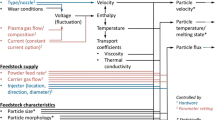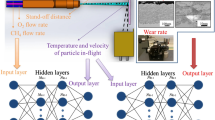Abstract
Previous work conducted on atmospheric plasma spraying has shown the importance of including the measured gun voltage in the modeling procedure to improve the outputs prediction quality. Given a set of controllable input parameters, the produced coating specifications are influenced by the gun voltage measured during the spraying process. As the gun voltage can only be measured once the coating process has started, making predictions about the expected voltage is necessary to better select the process inputs that produce a coating with desired specifications. We suggest that the gun voltage is related to the status of the manufacturing equipment. Exploiting voltage information, we propose a modeling and configuration procedure that uses Gaussian process regression and Kalman filtering to reduce the impact of session-to-session equipment changes as well as in-session equipment wearing. We then demonstrate this approach in simulation and experiments, using an industrial atmospheric plasma spraying setup to produce YSZ coatings.








Similar content being viewed by others
Change history
24 May 2023
A Correction to this paper has been published: https://doi.org/10.1007/s11666-023-01600-7
References
L. Leblanc and C. Moreau, Study on the Long-Term Stability of Plasma Spraying, Proc. Int. Therm. Spray Conf., 2000, 11, p 1233-1240.
F. Gao, X. Huang, R. Liu and Q. Yang, Optimization of Plasma Spray Process Using Statistical Methods, J. Therm. Spray Technol., 2012, 21, p 176-186.
Z. Wu, Empirical Modeling for Processing Parameters’ Effects on Coating Properties in Plasma Spraying Process, J. Manuf. Process., 2015, 19, p 1-13.
S. Datta, D.K. Pratihar and P.P. Bandyopadhyay, Modeling of Plasma Spray Coating Process Using Statistical Regression Analysis, Int. J. Adv. Manuf. Technol., 2013, 65(5-8), p 967-980.
A.F. Kanta, G. Montavon, M. Vardelle, M.P. Planche, C.C. Berndt and C. Coddet, Artificial Neural Networks vs. Fuzzy Logic: Simple Tools to Predict and Control Complex Processes—Application to Plasma Spray Processes, J. Therm. Spray Technol., 2008, 17(3), p 365-376.
A.F. Kanta, G. Montavon, M.P. Planche and C. Coddet, Artificial Neural Networks Implementation in Plasma Spray Process: Prediction of Power Parameters and In-Flight Particle Characteristics vs. Desired Coating Structural Attributes, Surf. Coat. Technol., 2009, 203(22), p 3361-3369.
M. Friis and C. Persson, Control of Thermal Spray Processes by Means of Process Maps and Process Windows, J. Therm. Spray Technol., 2003, 12(1), p 44-52.
S. Sampath, V. Srinivasan, A. Valarezo, A. Vaidya and T. Streibl, Sensing, Control, and In Situ Measurement of Coating Properties: An Integrated Approach Toward Establishing Process-Property Correlations, J. Therm. Spray Technol., 2009, 18(2), p 243-255.
X. Guidetti, A. Rupenyan, L. Fassl, M. Nabavi, and J. Lygeros, Plasma Spray Process Parameters Configuration Using Sample-Efficient Batch Bayesian Optimization. 2021 IEEE 17th International Conference on Automation Science and Engineering (CASE), (2021), pp. 31-38
C.E. Rasmussen and C.K.I. Williams, Gaussian Processes for Machine Learning, The MIT Press, 2006.
C. Chui and G. Chen, Kalman Filtering: With Real-Time Applications, 4th ed. Springer, 2009.
Acknowledgments
This project has been funded by the Swiss Innovation Agency (Innosuisse), grant Nr. 37896, and by the Swiss National Science Foundation under NCCR Automation.
Author information
Authors and Affiliations
Corresponding author
Additional information
Publisher's Note
Springer Nature remains neutral with regard to jurisdictional claims in published maps and institutional affiliations.
This article is an invited paper selected from presentations at the 2022 International Thermal Spray Conference, held May 4–6, 2022 in Vienna, Austria, and has been expanded from the original presentation. The issue was organized by André McDonald, University of Alberta (Lead Editor); Yuk-Chiu Lau, General Electric Power; Fardad Azarmi, North Dakota State University; Filofteia-Laura Toma, Fraunhofer Institute for Material and Beam Technology; Heli Koivuluoto, Tampere University; Jan Cizek, Institute of Plasma Physics, Czech Academy of Sciences; Emine Bakan, Forschungszentrum Jülich GmbH; Šárka Houdková, University of West Bohemia; and Hua Li, Ningbo Institute of Materials Technology and Engineering, CAS.
The original online version of this article was revised: When originally published, the HTML version of the article did not include the special issue tagline. The special issue tagline has been added to the HTML version of the article.
Rights and permissions
Springer Nature or its licensor (e.g. a society or other partner) holds exclusive rights to this article under a publishing agreement with the author(s) or other rightsholder(s); author self-archiving of the accepted manuscript version of this article is solely governed by the terms of such publishing agreement and applicable law.
About this article
Cite this article
Guidetti, X., Rupenyan, A., Sichani, E.F. et al. Spraying Parameters Selection Based on Predicted Equipment Status: A Study on Measured Voltage. J Therm Spray Tech 32, 523–531 (2023). https://doi.org/10.1007/s11666-022-01489-8
Received:
Revised:
Accepted:
Published:
Issue Date:
DOI: https://doi.org/10.1007/s11666-022-01489-8




